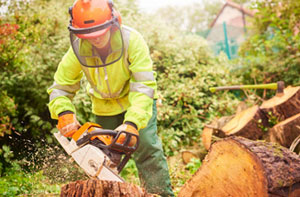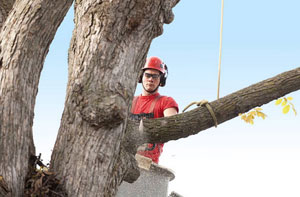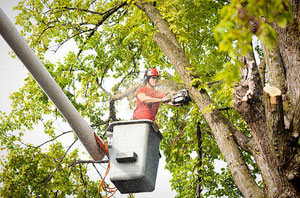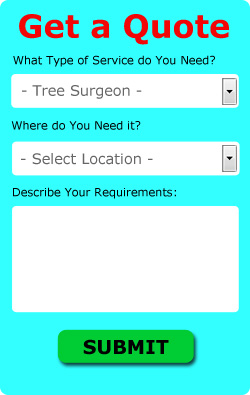Southwick Tree Surgeon West Sussex: Adding structure, substance and style to what can oftentimes be a 2 dimensional landscape, trees are an important feature of gardens and properties in Southwick. But when neglected or affected by extreme weather conditions, for instance flooding or high winds, trees can be a bit of a problem. The safest option if there's work that needs completing on your trees, is to consult an experienced tree surgeon in Southwick.
People in Southwick who try to do tree work on their own, or by using a non-qualified individual could risk causing damage to the trees, to property and to life. However, even for qualified tree surgeons who are aware of all the hazards, tree work is not entirely safe. Within the industry there are a worrying average of 3 deaths and 140 major injuries annually, making tree surgery among the most dangerous jobs in the UK.

With around five people a year being fatally wounded by falling branches and trees in the United Kingdom, even a damaged or poorly maintained tree can also present a danger to life. You could be liable for any compensation to any third-party due to the consequences of your actions, if you bring in somebody to perform tree work and there is an injury, or damage to property. The above are just some of the reasons why it is important to use a trained tree surgeon to work on your trees. (Source - HSE UK).
PICKING A TREE SURGEON IN SOUTHWICK - There are 2 professional industry bodies that a qualified tree surgeon in Southwick should really be an approved member of. You can view the membership and professional standing of any Southwick tree surgeon on the websites of either the Arboricultural Association (AA) or the International Society of Arboriculture (ISA). To find out if any particular local tree surgeon has ARB Approved Contractor status and has membership of either of these associations, you can check on this page.
You will be able to contact these professional associations for mediation assistance and for advice and help, if a problem emerges at any stage during the course of the tree work, or after it has been concluded.

If anyone who isn't on this directory list offers you a quotation, you should politely decline their offer of work and carry on your search for an approved contractor. You should try and get at least 3 different estimates from various companies in the Southwick area when you're reassured of their professional accreditations and associations. You should ask the below questions whilst getting the quotations, stating you need them to provide the answers because of the risks of the work involved:
- Exactly what level of insurance cover have you got? Don't even consider a tree surgeon in Southwick with less than five million pounds public liability insurance as outlined by the AA and ISA.
- Have you got documents to demonstrate that you have the recommended qualifications, membership of the AA or ISA, and also a certificate for basic chainsaw use from the NPTC? It is required by law that any tree surgeon/operative who uses a chainsaw must have gained a NPTC/LANTRA certificate. Certificates and National Diplomas in Arboriculture are qualifications that might be held by a professional tree surgeon in Southwick.
- Can you give me a quotation in writing? You should NEVER settle for just a verbal quote. Only ever accept a written quote.
- Is It Possible To contact a recent person who you've worked for so that I can check the standard of your tree work? Doing an independent examination of any recent work is always advisable.
On the written quote that you receive, you will need there to be clear and accurate specifics of all the tree work that is to be undertaken. Who is responsible for the removal and disposal of tree branches, stumps and waste should be stated, as should information on any trees which could be protected in law, and the required steps to obtain permission to work on them. You should also make sure that VAT has been included on the quotation. You have a responsibility to employ only competent tradespeople to work on your trees and property, and it is very important to understand that.
PRIOR TO WORK COMMENCING - The tree surgeon you have selected in Southwick, will look into whether any of your trees are subject to a protection order, and will consult with the local authority to find out if the go-ahead for any tree surgery is possible. Finding a tree has got protected status doesn't mean that work can't be carried out, since even protected trees need maintenance so as to cut back dead or damaged wood and ensure public safety.
A minimum of six weeks written notice must be given to the Local Planning Authority before any tree work can be undertaken, if your property in Southwick is inside a designated conservation area. However, tree stems of less than 7.5cm in diameter when measured at 1.5m from the ground are exempt from this requirement. Also, if a protected tree's branches need to be thinned or pruned to encourage and sustain growth, written notice won't be necessary.

On site they will complete a complete assessment of your tree's health and determine the remedial treatment required and how best to achieve the required outcome in a safe manner. This involves completing a risk assessment to include public spaces, your property and any parts of neighbouring properties that could be affected by falling branches and debris. At this point, the number of workers needed and the level of protection required will also be established. This is both personal protection equipment as well as other safety precautions to keep the public and other property safe from damage or harm.
ON THE DAY OF WORK - Cones, barriers and safety measures will be put in place before any tree felling, cutting of branches or climbing is started, to keep unauthorised persons and passers-by away from the work area. When there is a possibility of debris falling onto a highway, it may be necessary to briefly halt the traffic.
Subject to the kind of work that's required a tree surgeon will need varying levels of protection. At the very least when doing chainsaw work they will be wearing protective clothing to prevent serious cutting injuries to the legs, torso and hands. Without exception, every worker involved in the operation should wear head and eye protection, and high-vis clothing.
If working at height is involved, ladders and associated climbing equipment will need to be used, and extra workforce will be on hand to help in the safe removal of high branches and sections of tree trunk. For transporting waste materials away from the area, a skip or truck will be stationed as close to the work area as possible. This need for access is as good a reason as any for informing your next door neighbours of the proposed work.
UPON COMPLETION OF WORK - Upon completion of all the work, the site can be cleared of all debris, and all the waste can be taken away. A certificate of work will then be created by your tree surgeon, particularly where the trees are under a protection order, which will be signed off and a copy presented to you. Any safety measures that were put in public areas can then be removed, with footpaths and highways being re-opened to the public.
Problems or issues should be rectified straight away by approaching your tree surgeon directly. If your tree surgeon is a signed up member of a professional body, and any further arbitration is needed, you can receive help and advice from the Arboricultural Association or the International Society of Arboriculture in order to reach a satisfactory conclusion.
Local Southwick tree surgeons will most likely have the postcode BN42 and the telephone code 01273. They will work in Southwick itself, as well as nearby areas such as Fishergate, Worthing, Broadwater, Portslade, Upper Beeding, Hove, Sompting, Storrington, Wiston, Goring, Shoreham-by-Sea, Small Dole, Lancing, Fulking, Ashington, Woodmancote, Coombes, Findon, and these postcodes: BN42 4HQ, BN42 4RY, BN42 4HP, BN42 4FS, BN41 1SX, BN42 4DW, BN42 4FN, BN42 4JD, BN42 4HG, BN42 4LT.
If you require this kind of assistance it is certainly better to employ an approved tree surgeon. Southwick homeowners can benefit from the skills and knowhow offered by a fully trained professional.
Health and Safety Considerations

Tree surgery can definitely be a very dangerous undertaking if carried out badly, so one of the principle considerations is the safety issue. Inexperienced or incapable "tree surgeons" in Southwick are liable to cut corners and just disregard accepted safety advice, with the result that there may be not putting on hearing or eye protection, not roping off the area to safeguard passing pedestrians and vehicles, failing to put on cut resistant (chainsaw-proof) apparel (especially boots and leggings), falling branches and timber, no head protection and little if any protection from falling, in the shape of ropes, harnesses and platforms. What may be at risk due to these inadequacies are garden sheds and fencing, the tree surgeon himself (up the tree), the tree itself, nearby buildings, passing pedestrians, the property owners family, the street facilities, parked and passing vehicles, team members working on the ground.
Skills Needed to be a Tree Surgeon in Southwick
- To be meticulous and pay attention to detail.
- Physical skills like coordination and movement.
- The ability to work efficiently with others.
- Be conscious of the dangers and complexities involved with the various areas of the work.
- Be able to work with your hands.
- Have a good understanding of public safety and security.
- Have necessary computer skills and know how to complete basic tasks with handheld devices.
- Have the ability to use, maintain and repair equipment and tools.
- Have good customer service skills.
- Be professional and able to complete tasks within a given timeframe.
- Be patient and have the ability to stay calm and focused in times of stress.
Accidents Through Tree Surgery
As we've already said, tree surgeons and tree care professionals in Southwick carry out work that can be pretty hazardous. With a high risk of injuries to both operatives and passers-by, all possible safety measures should be implemented when working on trees.
According to figures gathered by the HSE (Health & Safety Executive), the use of chainsaws, falls from trees, and being hit by a falling tree or branch are responsible for a large majority of serious and fatal injuries. Surprisingly, those people working in tree care have a greater chance of injuring themselves seriously than those in the construction industry.
The most commonplace tree work accidents are being struck by objects (cranes, trees, branches, grapple hooks, ropes etc), falling from ladders and lifting injuries, with regards to insurance claims.
That is why employing a certified Southwick tree surgeon is so crucial when you have tree care work that needs doing. Unskilled workers trying to tackle tasks that they haven't been trained to do, accounts for many accidents in the tree care industry. Using an experienced and reputable company that's been trading in the Southwick area for a good few years, is the most effective way to avoid such issues, and get your tree care work done safely.
Dutch Elm Disease
Although Dutch Elm Disease (Ophiostoma novo-ulmi) is not quite the concern that is was previously, over the last 50 yrs or more it has killed many millions of precious elm trees right through Britain. Unintentionally imported into Britain from Canada in the nineteen sixties, Dutch Elm Disease (DED) is spread by the elm bark beetle (particularly the Scolytus genus) and caused by the Ophiostoma novo-ulmi fungus.
Through the nationwide transportation of elm products like mulching bark, elm crates, saplings, and logs with the bark still attached, it spread quickly through Britain after its initial arrival. This horrific disease didn't just impact elms in the UK, but also devastated tree stocks in mainland Europe and North America. Although the origins of Dutch Elm Disease are unproven, the suspicions are that it first came from Asia (possibly Japan).
The symptoms of DED usually appear first in early summer, and manifest themselves as:
- Clusters of leaves that turn yellow, wilt and fall.
- Dark streaks underneath the bark of twigs.
- New shoots dying back from the tips.
- A "shepherd's crook" reaction on affected twigs.
As a consequence of disease and the subsequent felling of dead, infected and dying trees, there are not many large elms surviving in the UK countryside, therefore the spread has slowed down and the beetle's favourite habitat essentially removed. The propagation of young saplings which are resistant to Dutch Elm Disease is an ongoing project.
You can ask for a diagnosis from the THDAS (Tree Health Diagnostic and Advisory Service), or you can speak to your local tree surgeon for guidance, if you have elm trees in your garden in Southwick, and have suspicions that they may be afflicted with DED.
Trees of the genus Ulmcae and Zelkova are affected.
Agent of spread - beetles of the Scolytus genera.
Cause - fungi Ophiostoma Ulmi & Ophiostoma Novo-Ulmi.
The International Society of Arboriculture (ISA)
Generally simply referred to as the ISA, the International Society of Arboriculture is headquartered in Georgia, USA, and is a non-profit organisation. Providing qualifications for tree care specialists across the world, the ISA is a membership association that supports the professional practice of arboriculture.
Supporting best tree care practices through educational events, publications and services, the ISA has a firm focus on allowing individuals in the tree care industry develop their knowledge, skills and arboricultural expertise whenever possible.
In 2016 the UK's Arboricultural Association was accepted as an associate organisation of the International Society of Arboriculture after signing a partnership agreement with them. Providing further opportunities for ISA members in the United Kingdom and Ireland, this also strengthened the relationship between the two organisations. AA members in Great Britain and Ireland now benefit from being part of a worldwide network of tree care professionals. The ISA now has professional affiliates and associate organisations in EXTRApest management, tree transplanting in Southwick, safety inspections in Southwick, tree reshaping Southwick, drop crotching in Southwick, landscaping Southwick, fruit tree pruning, root pruning, tree waste removal, brush cutting services, crown lifting, formative pruning, tree reduction, root decompaction Southwick, the removal of dead wood, woodchipping Southwick, cable bracing, tree work, tree cutting in Southwick, hedge reduction, staking, waste removal, tree management, vegetation management, tree planning in Southwick, crown cleaning, tree dismantling, tree pruning in Southwick, forestry management, woodland clearance in SouthwickTEN, and the UK, and now has an international membership of more than 22,000.
Air-Spading Southwick
There are various issues that could make the health of your trees a concern, however problems with the root system are frequently the cause. An experienced Southwick tree surgeon may need to gain access to your tree's root system, so as to check for problems such as soil compaction or root rot.
Due to the chance of root damage in the process of digging down, this was difficult to do until recently. To effectively break up and remove compressed soil without damaging tree roots or underground utilities, a contemporary system that's frequently used is "air spading".
On occasion, foot traffic, passing vehicles or building work can cause the soil around a tree's roots to get compacted, and this is known to have a negative impact on its health. When a tree lacks water and nutrients it can quickly become "stressed", and this means that it's more susceptible to attack by pests, insects and diseases. There can also be problems with root flare, when the flare around the base of the trunk gets covered with an excess of soil, causing the tissue to break down, and heightening the possibility of root rot. Air-spading is a useful technique for resolving this.
The ingenious air spading process involves the use of an air-spade and an air compressor which directs air into the soil at a speed of twelve hundred miles per hour, the air penetrates the voids in the soil and quickly breaks it apart, whilst leaving tree roots and nearby utilities undamaged. As compacted soil is blown away from the tree's roots by the powerful flow of air, immediate inspection is possible. A resolution can then be found for any any obvious problems, and the previously compact soil replaced with wood chips and fertiliser to help encourage the tree to revive. (Tags: Air-Spade Southwick, Air-Spading Southwick, Air-Spade Investigations Southwick).
Tree Emergencies Southwick
If you happen to have trees growing in your garden in Southwick, there might be situations when you need to call an emergency tree surgeon. Tree surgeons in Southwick expect to receive a huge spike in emergency call-outs when there are gales and high winds, which is why many offer a 24 hour service for this eventuality. Even though the risk of an entire tree toppling over are low, there is more potential for branches breaking off and crashing to the ground below, during gusty weather. Frequent issues that happen due to tree emergencies are splintered sheds, smashed greenhouses, damaged fences and broken garden furniture.
There is also a requirement for emergency tree care services by the local council in the Southwick area, when public pathways, railway tracks and roads get obstructed by fallen trees and branches.
There may be a need for "re-balancing" a tree, even after emergency tree surgery has been successfully carried out, as because of the loss of some limbs, there might be a weight distribution problem, which could be hazardous but also aesthetically displeasing. A local Southwick tree surgeon who offers 24 hour emergency services must be called in to handle all of these issues, and you should not try to sort them out yourself. You can also obtain emergency tree care services in Fishergate, Worthing, Broadwater, Portslade, Upper Beeding, Hove, Sompting, Storrington, Wiston, Goring, Shoreham-by-Sea, Small Dole, Lancing, Fulking, Ashington, Woodmancote, Coombes, Findon, and Southwick, West Sussex.
Chainsaws in Tree Surgery

The most dangerous and perhaps the most commonplace tool which is used by tree surgeons in Southwick, is the chainsaw. Petrol driven chainsaws are the most popular with professionals, due to their ease of use and portability, although mains models are available, and rechargeable battery chainsaws are growing more popular for some operations. Petrol chainsaws are the only real choice for substantial tree work, being extremely powerful, robust and able to slice through trunks and branches of any size.
A chainsaw basically comprises a rotating motor-driven chain which is lined with a series of razor-sharp teeth which slice through the bark of a tree and the wood beneath. For the different operations they perform, there are various types of chainsaw, rear-handled for working on the ground (two handed), top-handled for working at height (and which can be used with one hand if necessary) and pole saws for long distance pruning and hard to reach branches.
Despite the fact that holding onto a twirling blade while balancing precariously up a tree is certainly not the safest job on the planet, it's rare to find a tree surgeon in Southwick who doesn't use a chainsaw in their day-to-day activities. To be able to gain membership of the Arboricultural Association, being fully trained in the safe use of chainsaws is one of the key requirements.
There are countless different makes and models of chainsaw, but the most commonly used by professionals in the United Kingdom are Hyundai, Makita, Husqvarna and Stihl.
Tree Surgery Tasks Southwick

Southwick tree surgeons can generally help you with pest management, tree transplanting in Southwick, safety inspections in Southwick, tree reshaping Southwick, drop crotching in Southwick, landscaping Southwick, fruit tree pruning, root pruning, tree waste removal, brush cutting services, crown lifting, formative pruning, tree reduction, root decompaction Southwick, the removal of dead wood, woodchipping Southwick, cable bracing, tree work, tree cutting in Southwick, hedge reduction, staking, waste removal, tree management, vegetation management, tree planning in Southwick, crown cleaning, tree dismantling, tree pruning in Southwick, forestry management, woodland clearance in Southwick and other tree surgeon services in Southwick, West Sussex. These are just some of the activities that are undertaken by a tree surgeon. Southwick specialists will be happy to inform you of their entire range of services.
Tree Surgeons Nearby
Also find: Wiston tree surgeon, Findon tree surgeon, Woodmancote tree surgeon, Broadwater tree surgeon, Coombes tree surgeon, Small Dole tree surgeon, Fulking tree surgeon, Goring tree surgeon, Upper Beeding tree surgeon, Fishergate tree surgeon and more. Most of these localities are served by local tree surgeons. Home and property owners in the area can acquire estimates for tree surgery by clicking here.
Tree Care Services Southwick
- Southwick Cable Bracing
- Southwick Hedge Cutting
- Southwick Shrub Maintenance
- Southwick Crown Raising
- Southwick Crown Removal
- Southwick Crown Lifting
- Southwick Root Grinding
- Southwick Vegetation Management
- Southwick Tree Surveys
- Southwick Tree Bracing
- Southwick Tree Pollarding
- Southwick Tree Inspections
- Southwick Tree Dismantling
- Southwick Soil Terravention
 Tree Surgeon Southwick
Tree Surgeon Southwick Tree Surgeons Southwick
Tree Surgeons Southwick Tree Surgery Southwick
Tree Surgery SouthwickIf you want local Southwick information click here
Tree Surgery BN42 area, telephone code 01273.
Tree Care Southwick - Tree Surgeon Southwick - Vegetation Management Southwick - BN42 - Tree Management Southwick - Tree Removal Southwick - 01273 - Forest Management Southwick - Tree Surgeons Southwick






